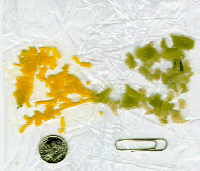
Melissa
Kaplan's
Herp Care Collection
Last updated
January 1, 2014
Iguana Salad: What size should it be?
©1996 Melissa Kaplan
If you are ending up with puree or mush, then you are processing the vegetables too much. Do you know what cous cous is, or tabouleh? If not, next time you are at the grocery store, stop by the health foods section, or check out the health food store. A couple of companies (Near East, Fantastic Foods) make packaged mixes of these Middle Eastern dishes. Your salad pieces can actually be a little bigger than these. Mine comes out so that the shreds of squash and parsnip (or carrots if I'm using carrots) come out distinct, and the green beans I've steel-knifed, while very small, can still be identified as pieces of green bean. The fruit is the only thing that really gets mushed because of it's high water content and that is actually beneficial as it gives more juice to dissolve the alfalfa pellets.
Shredded
squash and steel-knifed green beans
For scale: Dime (U.S. ten-cent piece= 17mm) and medium paper clip

Food processors give much better results than blenders. Check out garage sales, discount appliance stores, and department store sales. There are many brands out there now where you can find relatively large capacity machines (5-8 cups) for a good price. Remember that the machine capacity may look enormous compared to the amount of food that your baby iguana is now eating...but your lizard will grow a foot a year during the first several years, and its capacity to pack away prodigious amounts of food (and produce equally impressive amounts of poop!) will increase accordingly!
If you aren't sure what the vegetables and greens I recommend feeding look like, check out my Illustrated Reference.